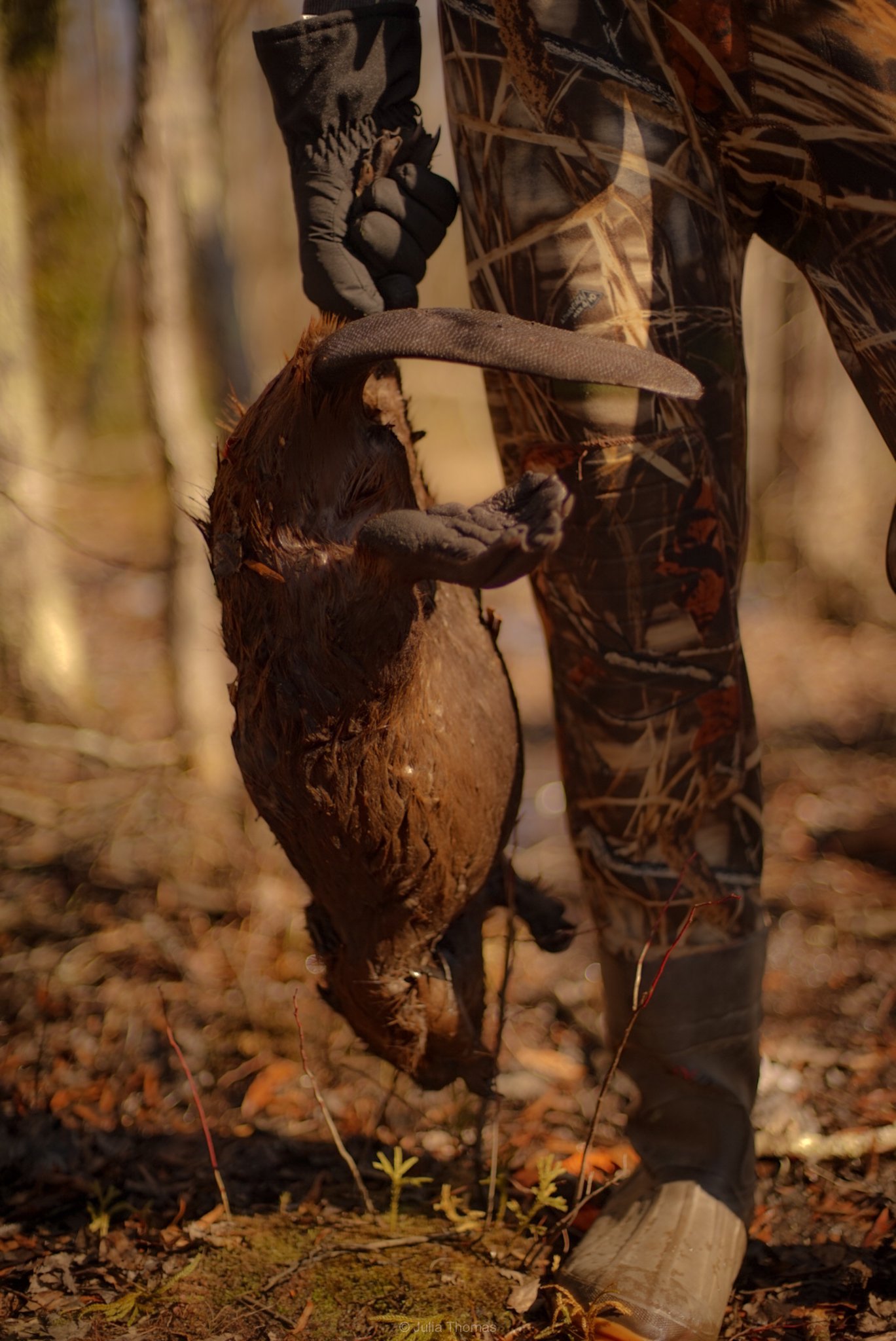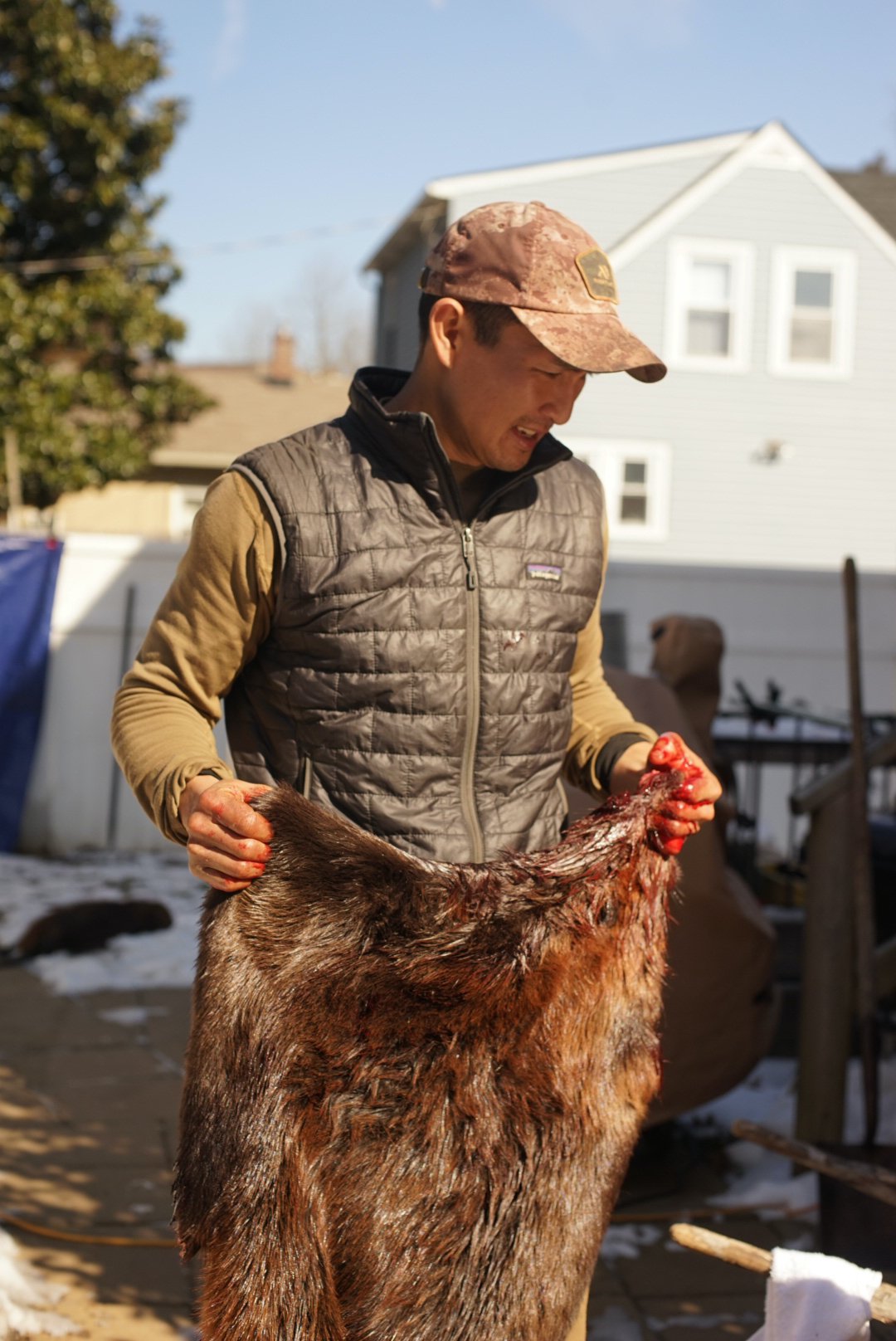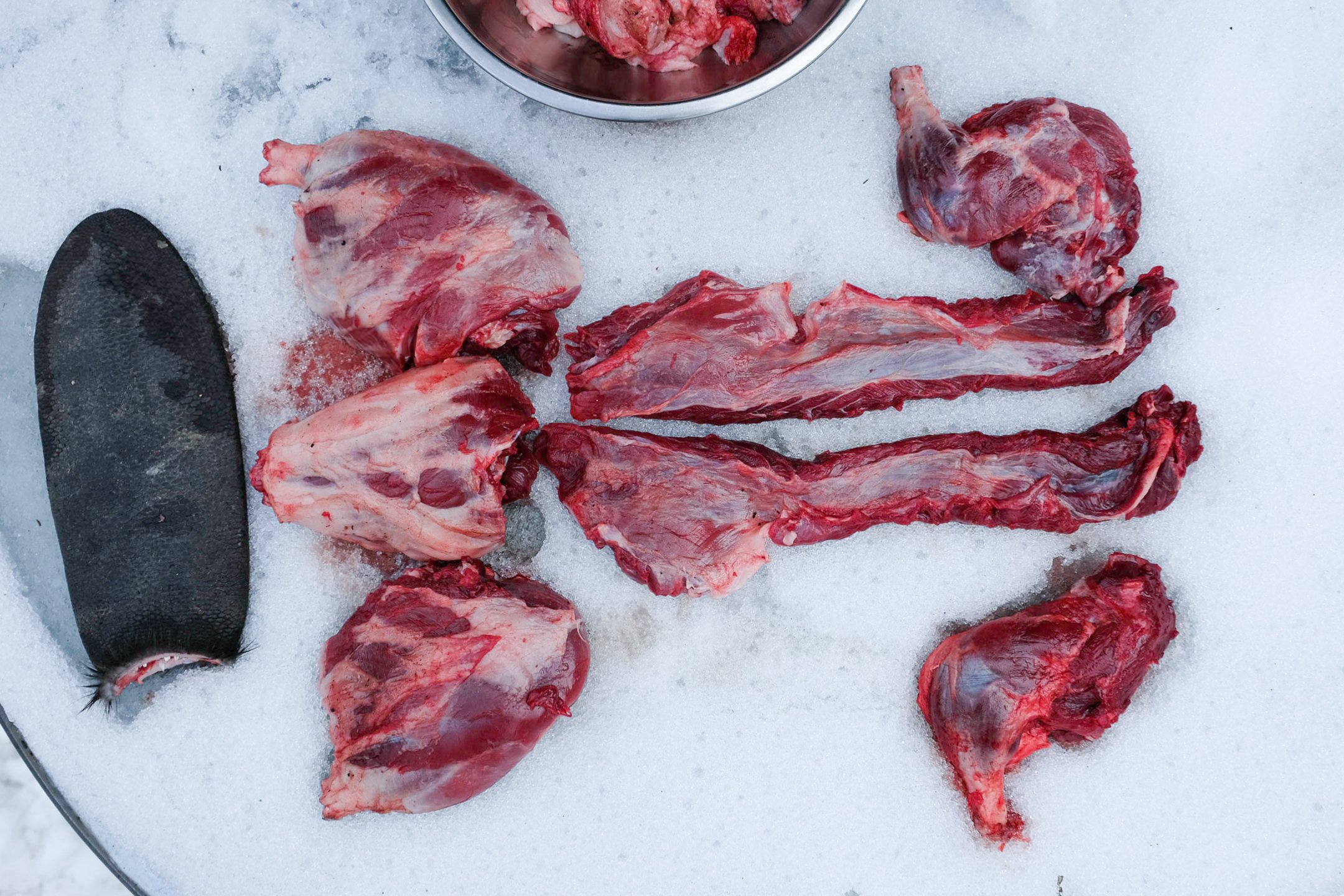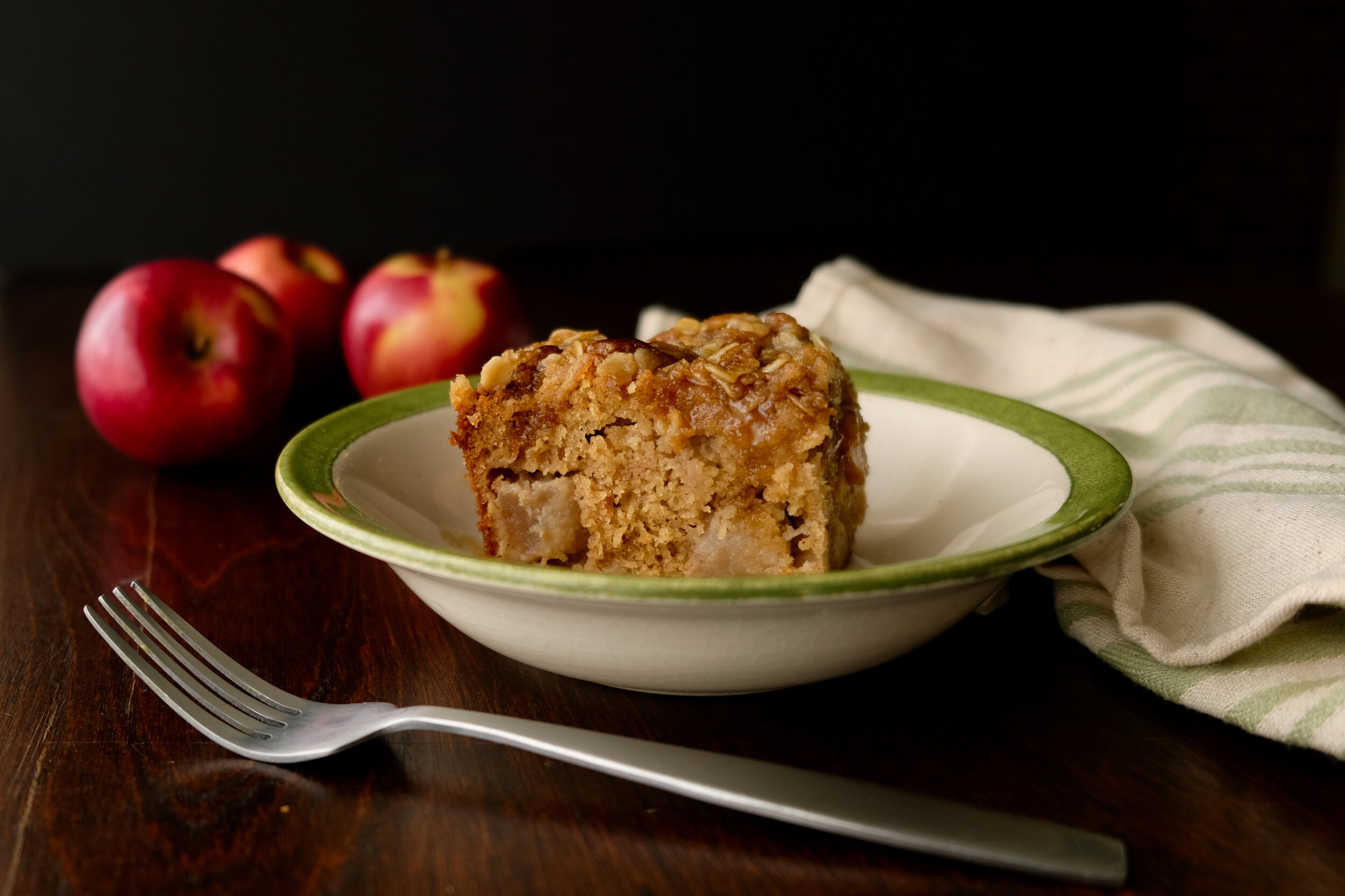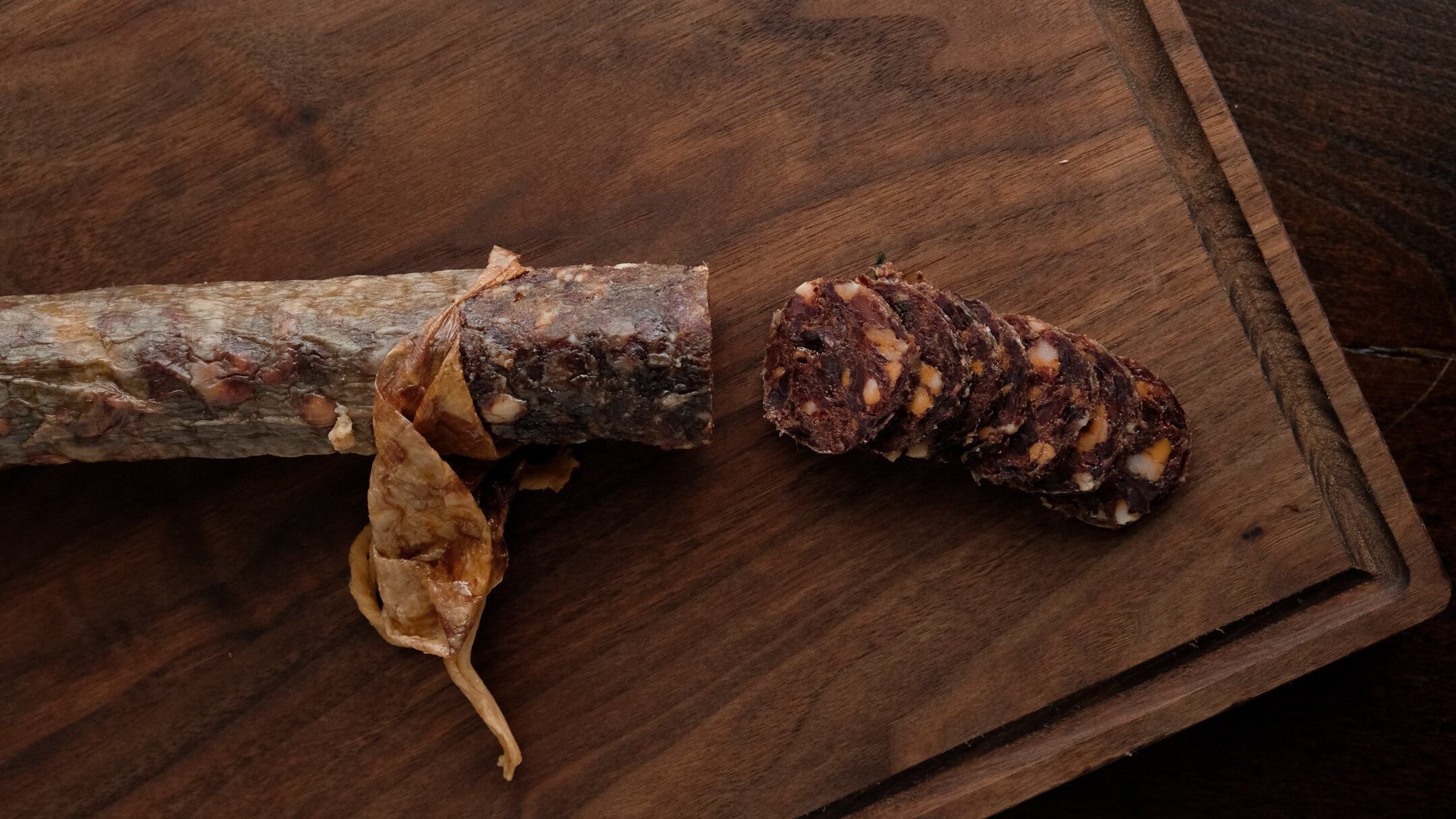How to: Eat a Beaver
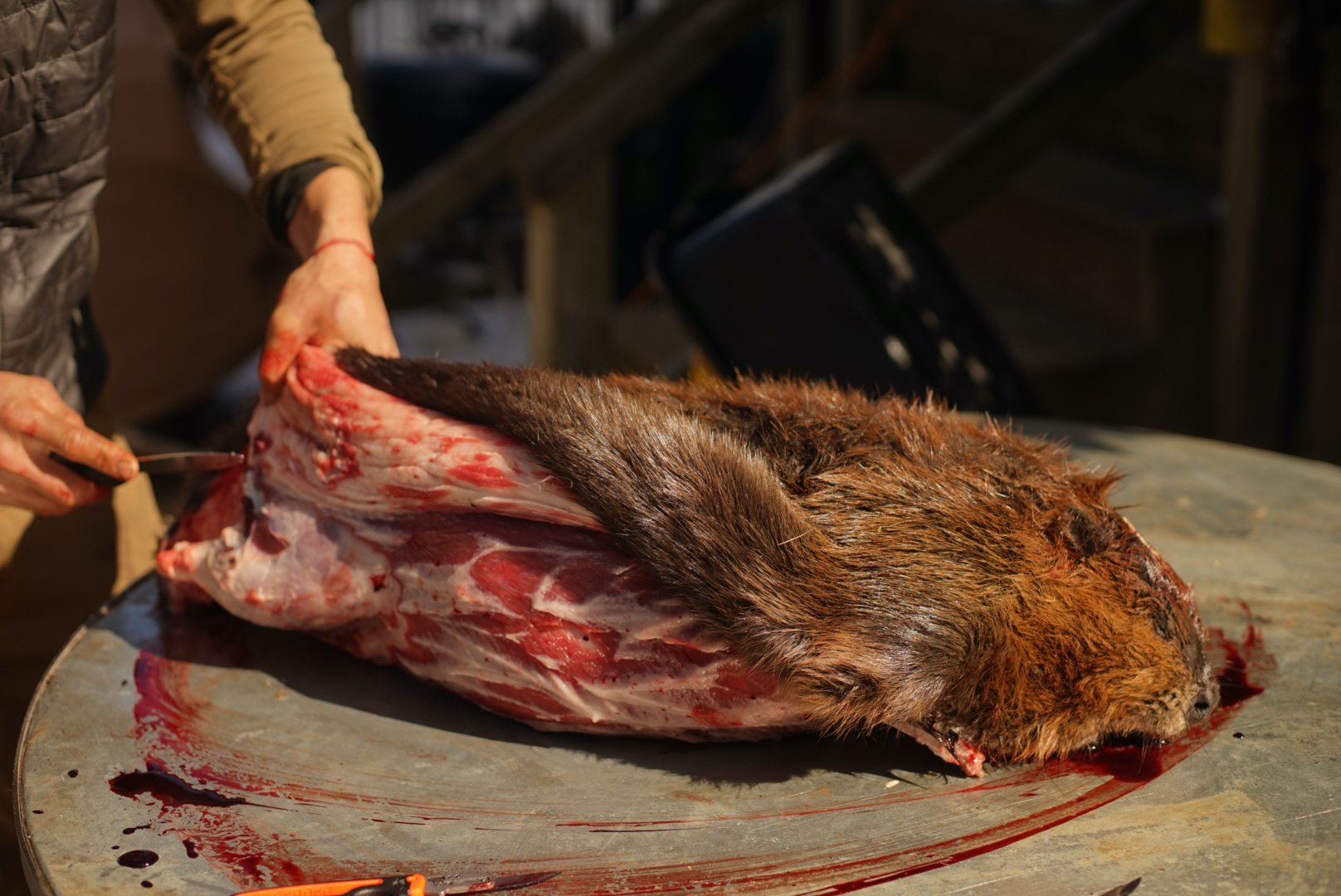
Before we started trapping, I would have never thought that beaver meat would be as good as it is.
I shot my first beaver at the request of a landowner whose property we hunted. Curious, I took the beaver home, butchered it, and made a simple stew. I didn’t think it would be bad, necessarily, but I wouldn’t say my expectations were all that high either. That dish turned out good, as stews are wont to do, and I mentally filed away beaver into the “good in stew” category (which is a pretty broad one).
I didn’t give beaver much thought for a couple of years after that, until I read a biography of Daniel Boone and the trapping bug hit me, hard. We trapped our first beavers shortly thereafter, and this time, the first thing we did was pull out the backstraps and sear them. They were incredible. Similar to elk or bison, beaver meat has a deep, woodsy character without any off-flavors, and is lean but succulent. It’s the sort of game meat you could serve to someone who claims not to like game meat. It’s what beef should be. The meat is clean and sweet-smelling, garnet-colored, and lean, with a thick cap of pristine fat under the skin.
We use beaver in stews, smoke it, grill it, grind it, and make charcuteries. There aren’t many applications that we can imagine where beaver wouldn't be a perfect substitute for any red meat. It is honestly a phenomenal protein, one that deserves to be prized. For us, the meat is the reason we got into trapping, it’s really not a byproduct of trapping for fur.
We wrote up this guide for people who might be curious about trapping and would like to utilize the meat. The little information we’ve found on the internet in the past falls into two main camps-
You’ll get beaver fever and die
I don’t know anyone who eats it, but I hear mountain men ate the tails
So most folks don’t have a lot to go off of. We hope this is helpful for anyone who is curious about adding beaver meat to their larder.
Safety considerations
We get a lot of questions about the safety of eating beaver meat, which, honestly, is not surprising. From rabbits to deer, beaver and bears, generally speaking, the answer is yes, most wild game is “safe to eat.” While some species may be more prized or palatable than others, you should know that most meat, properly cooked and handled, will not make you ill. But just like the risk of salmonella on a grocery store chicken, or trichinosis in a wild bear, there are considerations and risks associated with eating ALL things, and you should be knowledgeable of them. Make decisions using your best judgment for your own situation.
Giardiasis - also known as “beaver fever,” this is a parasite that infects the intestines of many mammals, humans included. It gets its name not from the consumption of beaver meat, but from the consumption of contaminated water in stagnant areas like beaver ponds. This is an illness that should be taken seriously- it’s why purifying water before you drink it is so important. The parasite lives in the intestine of host species and is passed through fecal matter. It does not live in the muscle tissue- the meat- of host species. In short, don't eat beaver poop and you’re well on your way to never having to deal with giardia. As an extra precaution, we often don’t even gut our beavers- we skin, then remove the quarters and backstraps- leaving the cavity intact.
Tularemia - mostly associated with rabbits, there is potential for beavers to carry tularemia. Wear gloves when handling rabbits, beavers (and any other animal for that matter) if you have open wounds on your hands. Biting insects are also a vector for this disease, so wear bug spray if it worries you. Because we trap beavers in late winter, when there aren't any biting insects out, we don't really worry about it.
Rabies - just like ANY mammal, beavers could (though rarely) carry rabies. The odds of beavers infecting anything with rabies is slim, although it has been reported. Avoid handling the teeth/saliva and wear gloves if you're worried about it. Avoid getting bit by beavers, or any animal for that matter.
Field considerations
Please note these guidelines are from our experiences- we have only trapped beavers in Virginia, and we trap them in the later part of the season (late January-February). The weather is generally cold, but can vary. Temps run from below freezing up to the mid 60s. We’re sure that in colder or warmer climates, some of these considerations could be moot, or be even more imperative.
Unlike most wild game that is consumed, beavers are generally trapped. If done correctly, the dying part is quick, not unlike proper shot placement on game. Where it deviates from hunting is the timing of the retrieval. When we kill a deer, we usually have it field dressed in short order. Removing the internal organs of an animal dumps a lot of thermal mass and allows the meat to cool much faster. The issue with trapping is that the time of death is unknown. The beaver might have died an hour before you checked the trap, or it might have been caught the evening before. This unknown variable could potentially impact the quality of the meat.
We’ve had just one iffy experience with beaver meat. The first beaver salami we ever made didn't turn out nearly as great as we had hoped. There was just a slight tangy-funk to it that we couldn't place. It didn't taste bad, but it wasn't as good as we had expected it would be. We went over the process and recipe a few times, and came up with a theory: there was some slight souring in the meat we used, most likely from the meat closest to the organs. The trapping season was long over by that time, so we had to wait until this season to have a chance to test our leading theory.
Our thought was that because beavers are so well insulated, and have proportionally large digestive systems, their internal heat has a hard time escaping, elevating the potential for spoilage, especially the meat closest to the organs. Even though all our beavers are caught in cold winter waters, their fur and fat insulates them longer than most other critters.
This season, after getting our first beaver home and skinning it, I opened up the abdominal cavity, cut back the flank meat and took a look and a deep smell. There was a slight sour note to the inside of the flank meat- very faint, but it was there. I also noticed that the tenderloins were not nearly as dark red as the rest of the meat was and were slightly off-colored- just a touch of gray to it. It wasn't glaringly obvious, but the meat around the abdomen was showing the first signs of spoilage. The rest of the meat- the front and hind quarters, tail, and backstrap had no discoloration and no off smells. Knowing this, we no longer use the flank meat or the tenderloins, especially not in curing projects like salamis.
Having answered our question, we have modified the way we process beavers and we have since had zero issues with beaver meat. These are our guidelines to help minimize meat loss from spoilage, and bridge the gap between fur handling and meat handling.
Check traps daily. This is generally a requirement in most states, but there are deviations. In Virginia, fully submerged body gripping traps can be left unchecked for up to 72 hours. We check our traps (even the fully submerged ones) daily, because we want to minimize the amount of time between killing the animal and processing it.
Check early. The earlier the better. You don't want to check traps too early, while beavers are still active, but we don't wait until late in the day, especially if it is getting warm. Again, this is to minimize the amount of time the animal is dead and unprocessed.
Process ASAP. We skin and process beavers as soon as we reasonably can. If you’re a long way from home, rough skinning and/or field dressing would be a good idea.
Trap in cold weather. We’ve been asked to trap problem beavers in the warmer months, and we have always declined. Around here, the shallow waters get bathtub warm, and we have no interest in killing animals and letting them soak in warm water for hours before we can get them processed.
Work clean. I make it a point to wear gloves and wash my hands between skinning, quartering and removing glands. Clean your knives and hands well after handling the castor glands. I also give the table a wipe down often. I don’t find the smell of castor repugnant, but it is strong, and not a smell you want to spread all over the meat. Avoid putting excess pressure on the abdomen of the beaver while you are working on it, especially after the skin is removed. You may force some of the gland liquids out onto the meat or your work area. Also, trapped beavers are bloody. Unlike shot game, there are no punctures for the blood to leave the body of a trap-killed animal.
Treat it like any game animal. I know practices vary from place to place, and person to person, but game meat is generally handled similarly: get the meat cool and work clean. Beaver should be no different. Also, for the love of all that is good, don’t soak any meat, ever, directly in ice water.
Break down:
Beavers break down like rabbits for the most part. You have quarters and back loins, but you have the addition of the tail and flapper, and if you really want to minimize waste, cheek meat as well.
Front quarters: These are small relative to the hind quarters. We usually debone these and use them in any recipe that would call for tougher cuts or grind. They work great on the bone in any type of braise.
Hindquarters: These are the majority of the meat on a beaver. The hams look like miniature pork hams. We usually work with these whole, or debone and use for braises or grind.
Backstraps: These are very thin compared to backstraps from a deer or other big game, but are absolutely worth saving. We cut them from the pelvis up to the back end of the front quarters. There is a fair amount of connective tissue and silverskin that needs to be trimmed, but they cook up beautifully medium rare. They are also great sliced thin (across the grain) in stir fry, fajitas, or any other fast-high heat application. The meat doesn't get as dry as venison when cooked through because it’s a little fattier. It's become our go-to stir fry protein.
Tail muscle: This is the muscle behind the pelvis and before the flapper, and is hands-down the best part of the animal. Treat it like you would oxtail- braise it whole, or cut into segments between the joints. The meat is dense and rich, with a bit of fat and connective tissue to it. It’s a little like a shank, but better. Every meal we’ve made with the tail muscle is one of the best we’ve ever had.
Flapper: The flapper is mostly fat and connective tissue. This is what people are talking about when they re-tell the old story about mountain men eating the tails. After skinning, the flapper is somewhere between pork fat back and the gristle on a steak, texturally. There’s really not a lot of flavor there, but there is plenty of chewiness if that is your thing. You could go mountain man style and char the skin off over fire, just for the experience of it. We wouldn’t recommend it though. As a survival food and much needed source of fat, sure. But if you actually want to enjoy it, you can carefully skin off the leathery hide and cure the flapper whole for beaver lardo, which goes great on a white pizza. You can also render it down, with the fat from the rest of the beaver, and use it as a cooking fat.
Cheeks: Like most mammals, the cheeks are one of the toughest, densest, and flavorful cuts on a beaver. These are second only to the tail muscle in terms of deliciousness. Braise or sous-vide over an extended period to yield rich and tender meat.
Bones: We use the bones for stock, they’re beefy in flavor and there are a lot of joints and cartilage, which makes for glossy sauces and richly textured broth.
Fat: There is a lot of fat on a beaver. We render most of this down and use the lard for cooking oil.
Organs: We’ve heard great things about beaver liver, and we imagine the heart is just as good as any other heart, but because of our experience with the slightly soured meat, we usually just dehydrate the organs for dog treats. They're both things we want to try, but have not yet. If we shoot a beaver, or process one that we know was only in the trap for a short amount of time, we’ll be doing some experimentation.

